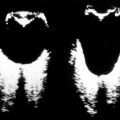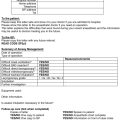Anaesthesia for Gynaecological and Genitourinary Surgery
TRANSURETHRAL RESECTION (TUR) SYNDROME
TUR syndrome occurs if a large volume of hypotonic irrigating solution is absorbed rapidly, resulting in rapid changes in serum osmolality and electrolyte concentrations. Glycine solution is the most commonly used hypotonic irrigating fluid in the UK, and commercial solutions have an osmolality of approximately 200 mosmol L− 1. In high concentrations, glycine can exhibit toxic effects on the cardiovascular and central nervous systems (including retinal neurotransmission) in addition to the effects of altered blood chemistry. The clinical findings associated with TUR syndrome are shown in Table 27.1.
TABLE 27.1
Clinical Features of TUR Syndrome
| Symptoms in the Awake Patient | Clinical Signs and Investigation Results |
| Vertigo | Confusion or agitation |
| Nausea and/or vomiting | Decreased consciousness |
| Abdominal pain | Seizures |
| Visual disturbance/blurred vision Dyspnoea Chest tightness |
Pupillary dilatation Papilloedema Bradypnoea/hypopnoea Pulmonary oedema Cyanosis Oliguria Hypotension (although there may be initial hypertension) Bradycardia or other dysrhythmias Widened QRS and/or ST changes on ECG Cardiac arrest Hyponatraemia Decreased serum osmolality Hyperammonaemia |
ANAESTHETIC IMPLICATIONS OF SPECIFIC SURGICAL TECHNIQUES
Prostate Surgery
Complications associated with TURP include blood loss, which can often be difficult to quantify because of the use of irrigation fluid. Other complications include hypothermia, sepsis and TUR syndrome. Although general anaesthesia using a laryngeal mask airway can be used, spinal anaesthesia is often the preferred anaesthetic technique for TURP because of the decreased risks of respiratory and airway dysfunction. Spinal anaesthesia may also provide the potential for early identification of TUR syndrome when monopolar techniques are used because confusion and agitation are amongst the earliest clinical signs (see Table 27.1).
Armitage, J.N., Sibanda, N., Cathcart, P.J., et al. Mortality in men admitted to hospital with acute urinary retention: database analysis. Br. Med. J. 2007;335:1199–1202.
Conacher, I.D., Soomro, N.A., Rix, D. Anaesthesia for laparoscopic urological surgery. Br. J. Anaesth. 2004;93:859–864.
Cousins, J., Howard, J., Borra, P. Principles of anaesthesia in urological surgery. Br. J. Urol. 2005;96:223–229.
Knight, D.J.W., Mahajan, R.P. Patient positioning in anaesthesia. Continuing Education in Anaesthesia, Critical Care and Pain. 2004;4:160–163.
Midgley, S., Tolley, D.A. Anaesthesia for laparoscopic surgery in urology. European Association of Urology Update Series. 2006;4:241–245.
Moore, J., McLeod, A. Anaesthesia for gynaecological oncology surgery. Current Anaesthesia & Critical Care. 2009;20:8–12.
O’Donnell, A.M., Foo, I.T.H. Anaesthesia for transurethral resection of the prostate. Continuing Education in Anaesthesia, Critical Care and Pain. 2009;9:92–96.
Park, E.Y., Koo, B.N., Min, K.T., Nam, S.H. The effect of pneumoperitoneum in the steep Trendelenburg position on cerebral oxygenation. Acta Anaesthesiol. Scand. 2009;53:895–899.
Vijayan, S. TURP syndrome. Trends in Anaesthesia and Critical Care. 2011;1:46–50.



